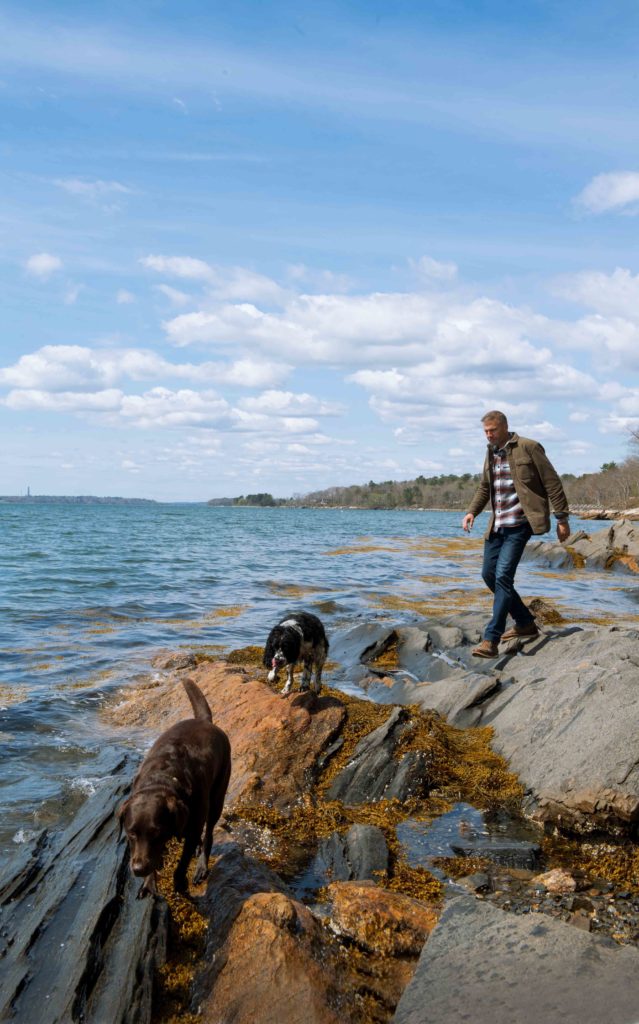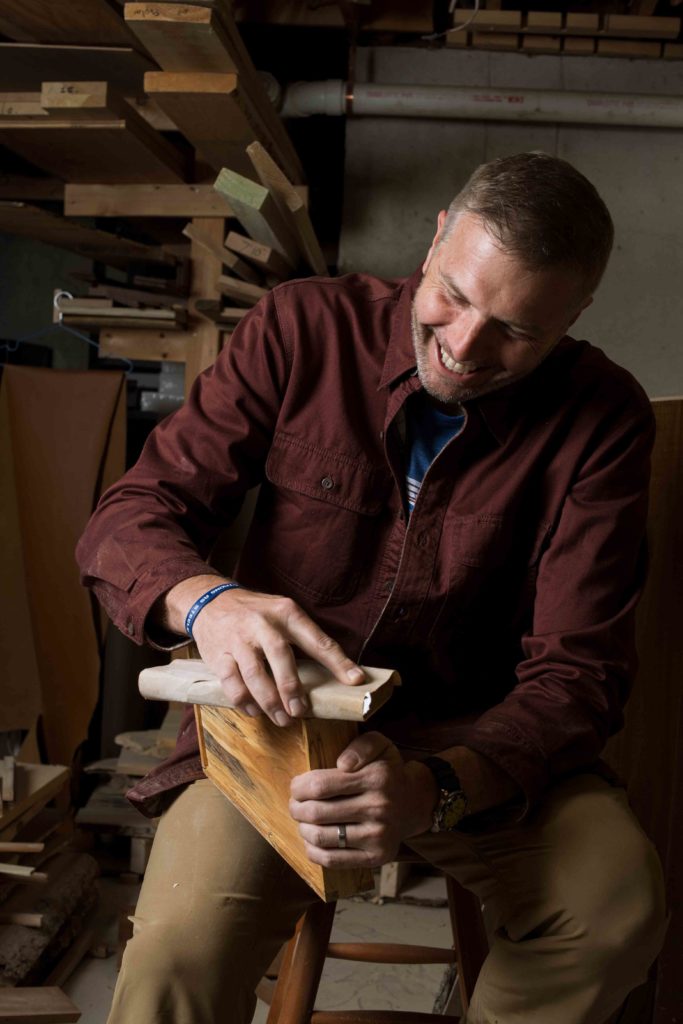Brand Steward
L.L.Bean president and CEO Stephen Smith on the future of retail, how the company adapts to a disrupted industry, and his woodworking obsession
When Stephen Smith joined L.L.Bean in 2016 as its fourth president and CEO, and the first hired from outside the company, it was a homecoming of sorts. At the time, Smith and his family were living in Shanghai while he was working for Yihaodian, a Chinese e-commerce subsidiary of Walmart International. But back in the late 1990s he had moved to Maine to work at Resort Sports Network, and later served as director of marketing at Hannaford in Scarborough. Ever since the job at L.L.Bean lured him back, Smith has embraced Maine’s four seasons and outdoor offerings. “You can go out West, and you could have amazing mountains and rivers, but you have no ocean and no lakes. You can go into areas in the Midwest, and you could have amazing lake and river culture, but no mountains and coasts,” he says. “Maine is truly spectacular for what nature has provided for you.”

What are your favorite places in Maine to get outside?
First and foremost is out my back door. I live in Yarmouth, so getting out to Littlejohn Island and Pemasong—beautiful hiking trails there. I love to spend time out in the confluence of the Royal and the Cousins Rivers, which then goes out to Lanes Island. That whole body of water out there is great for standup paddleboarding and kayaking and striper fishing and even waterskiing. From a trip perspective, I’ve loved getting to know Baxter and Katahdin Woods and Waters. I went up to Katahdin Woods and Waters with Lucas St. Clair right as it was being named a new monument, and I got a personal guided tour. We hiked, we mountain biked, we swam in some of the rivers. I loved the ruggedness of it. It’s amazing. And then a couple years ago I did Katahdin. Last fall I went up and did the Traveler Loop, which involves going in the north gate of Baxter; it’s an amazing ten-mile trail that goes over three peaks in the northern part of the park. I also do the AMC huts. I skied between Medawisla and Gorman Chairback Lodges, up in the Greenville area. For hut-to-hut trips and out-and-back trips, they are absolutely spectacular.
How has your relationship with the state changed since becoming steward of such a quintessential Maine brand?
I’m a short chapter in a company that has been here for 108 years. Long before me, L.L.Bean and Maine have been inextricably linked. It was Governor Jock McKernan who said many years ago, “Is Maine Maine because of L.L.Bean, or is L.L Bean L.L.Bean because of Maine?” It really was created as a gateway to Maine. The original company was built for hunters and fishermen who were coming up from Boston and New York and going into the Maine woods. They needed guides and hunting and fishing apparel to go into the woods. And then they needed decent clothes to put on when they came out of the woods and got back on the train and had to go to work back in the major cities.
How has L.L.Bean retained that Maine connection now that it’s a global company?
The company has been built around Maine. The amazing thing, and something that actually isn’t reported very often, is that every single one of our products is designed here in Maine. Our product development teams, our designers, they all live here in the greater Portland area, and every product that is imagined and then created and sold comes out of the mind and the experience of our merchants, our product designers, and our product developers. It’s all done with a New England and a Maine sensibility in the products that we create. That also keeps us quite grounded in the seasons and in what the needs of a New Englander are, with Maine being the most rugged aspect of New England.

How do you think this pandemic will change retail in the long term?
It’s going to be heavy. Physical retail, people going into stores and into malls, that business already was heavily challenged and heavily disrupted. I think a lot of familiar brands are going to disappear, and people’s patterns are going to be changing and shifting. Just simply more people will be shopping online. No doubt about it. It’s just more easy and convenient. And store layouts will change. They’re going to become a bit more open, a bit less condensed.
How does L.L.Bean fit into that new reality?
There already was an important trend around experiences. We knew younger generations were buying less stuff, and they were spending more of their money on experiences. And that is going to dramatically accelerate. For L.L.Bean that’s exciting. We have always focused on getting people outside and creating shared memories outdoors, whether it’s our Outdoor Discovery Programs or people wanting to do things outdoors. Brands that enable people to do things outdoors and have experiences are going to be even more valuable.
It was big news when L.L.Bean changed its return policy in early 2018. How did that change come about, and what was the process for changing something that’s such a part of the company’s identity?
That had been identified before I arrived, and when I came, we embarked upon a major change agenda to improve the long-term health of the business. It had been identified early on that the original intent of the guarantee was that it was a relationship, and it was a partnership from L.L. originally. If you buy something and you are not satisfied—it was a satisfaction guarantee—then we’ll make good on that. Well, that interpretation of satisfaction over the years had moved to what people considered really a product replacement guarantee: should anything ever wear out, you will just replace it. But it was never intended to be that. And what we saw in 2010 to 2016 was that people—a small group, but doing it to a huge extent—were abusing the intent of the guarantee. They didn’t actually buy the products from us, and they were never actually unsatisfied. They were gaming the system. And it cost us tens of millions of dollars. We knew we wanted to still have a satisfaction guarantee, we knew we still wanted to have one of the best in the industry, but we needed to end the abuse of a generous policy. We did a ton of consumer research. We tested six different return policies with about 7,000 different customers through quantitative analysis. We worked with the family, with the board of directors, with our management team, with our customer service team, with our retail team to determine what the right return policy would be for us. It goes back to the original intention. It is still a 100 percent satisfaction guarantee. We simply said we need to know that you’re the person who actu-ally bought this, and then you have one year to decide if you are indeed satisfied or not satis-fied with the product, which is still an extraor-dinary return policy. Most return policies are 30 or 60 days, but you know far sooner than a year if you’re satisfied with something that you purchased.

I’ve heard you personally make your own furniture. How did you get into that?
It’s a story that hasn’t been told. It actually goes all the way back to being a kid. I spent my summers in the Adirondacks at my grandparents’ place, and my grandmother was very handy. It was an old camp that was built in 1894, all wood. Everything always needed to be repaired. I just got into building, rudimentary sort of carpentry. I always had interest in designing and building things, and I always liked to know how things work. At my second job at AT&T in New Jersey, I was on a team that would do all the analysis to figure out whatever a problem was, and then we would put together these huge presentations of how to solve that. And then we would hand that off to an implementation team. I realized early on that I found it incredibly unsatisfying, to do all the work but never actually get the final end product. To counter that, I started refinishing furniture, because I needed something tactile that I could do from start to finish, and when I was done, I could see the finished physical product. I started picking up old pieces of furniture, and as I would start repairing furniture, I would start figuring out how things were made. It just became one of the things I like to do as stress relief outside of work. I’m a bit obsessed about it, so I now mill my own lumber. I love the process of making furniture because it’s an amazing right brain/left brain exercise. You can envision an idea for a piece of furniture—it could be highly functional, it could be highly aesthetic—but you have to do the design work, which is really fun and creative.
Sometimes I look at a piece of wood, I look at the grain, and I think, ooh, that would be beautiful if I made X out of it. Make a table, make a chair, make a stool, make a bench, make a shelf, whatever. Then you convert that design into a practical plan, and you’re in the shop. You’re getting sweaty and you’re figuring out exactly what kind of joinery you want to use. You’re working with intricate tools. It’s all very, very tactile, so you can feel the contours of the wood. I love that whole process of building something with your hands. And then when you’re done, it’s a utility. It’s a piece of furniture.
What are you working on right now?
I’m moving into a smaller house on Cousins Island and doing some remodeling in there. I took down a maple tree on the property. I had it milled up, and I am now making the stair treads for that house from it, because I love that circular nature of it: that tree was there long before that house was there. It had to come down, based on some work that was being done, so I want to make sure that some part of that tree is coming back into the house.

